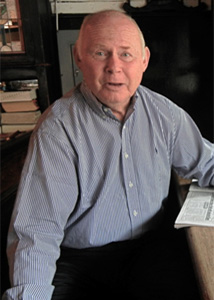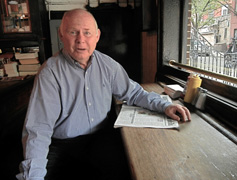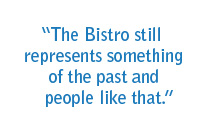 Bill O’Donnell has owned the ever-popular Corner Bistro at Jane and West 4th Streets for the past 45 years. Born in Westwood, New Jersey in 1935, he also owns the building that the Bistro is in and keeps an office above the bar. You can see him there most mornings. Bill lives with his wife, Lorraine, on Bank Street.
Bill O’Donnell has owned the ever-popular Corner Bistro at Jane and West 4th Streets for the past 45 years. Born in Westwood, New Jersey in 1935, he also owns the building that the Bistro is in and keeps an office above the bar. You can see him there most mornings. Bill lives with his wife, Lorraine, on Bank Street.
In the summer of 1952, Bill O’Donnell worked as a bellboy on the SS America, doing three 18-day tours. “Among other ports, we hit Le Havre and Bremerhaven and it was my first exposure to Europe,” he recalls. “I was sixteen and I looked about twelve and it was a real eye-opening experience. It was a lot of fun and an extraordinary amount of money for someone my age. The experience was ‘broadening’ is the best way to put it. It made my senior year difficult to finish because I went from that environment back to a Catholic high school!”
Was his tenure on the ship part of a grander life plan for O’Donnell? “I didn’t have any plans then and I still don’t!” he says, laughing. “I’m convinced that some days your life could be determined simply by which corner you turn. It’s that random.” He also claims to never have had a specific vocational drive or interest. “There were a lot of things I didn’t want to do,” he admits. “One was working in an office nine to five. I went back to college just to get an education and then I went back to sea for a while. I was toying with the idea of going to law school but that never materialized.”

At this time there was a bar on Greenwich Avenue named Jack Barry’s and the owner was looking for a weekend bartender. He asked O’Donnell to work until he figured out what he wanted to do. “I took that job and then a full-time bartending gig that opened up shortly after, never with the intention of continuing,” O’Donnell says. “A few years later, one of the two owners of the Corner Bistro—his name was Curtis—wanted to sell his interest. I scrambled together some money from my brothers and me and that’s how I began at the Corner Bistro. I took over 50% interest in February 1967 and ten years later bought the other 50%.”
The bar had a minimal menu back then so O’Donnell started serving hamburgers as the main attraction. “Some time around 1978 Mimi Sheraton, the food critic for The New York Times, came in and gave our hamburger a terrific review,” he says. “That started the genesis of the hamburger business and it took on a life of its own. Newspapers and magazines started picking up on it. It became a big part of the Bistro and grew into what we’ve become today: a hamburger destination.”
So what was the bar scene like back then? “It was much different,” says O’Donnell. “It was a mixed clientele and an eclectic crowd. You had neighborhood people, beatniks, some longshoreman, and tourists. You also had the aspiring actors, writers, poets and the intellectual types. So it was a collision of cultures and sometimes it didn’t mix so well! There seemed to be a lot more drinking then. Today you can’t do anything in a bar because as soon as someone belches too loudly people are on their cell phones!” He laughs, and continues. “I think the bar scene in general is much more peaceful than it was years ago.”
 In addition, the gentrification of the Village—particularly in the last ten years—has changed his clientele dramatically. “The crowd has gotten a lot younger,” O’Donnell says. “We have a group of standby older people that come late in the afternoon. We also do a lot of tourist business during the day as well. But at nighttime it’s all young people. I feel like Methusaleh if I go in at night. Most people are in their late twenties or early thirties. They’re that young!”
In addition, the gentrification of the Village—particularly in the last ten years—has changed his clientele dramatically. “The crowd has gotten a lot younger,” O’Donnell says. “We have a group of standby older people that come late in the afternoon. We also do a lot of tourist business during the day as well. But at nighttime it’s all young people. I feel like Methusaleh if I go in at night. Most people are in their late twenties or early thirties. They’re that young!”
For a fellow who started out with no clear life plan, it turns out that O’Donnell ended up doing pretty well after all. “I do take some pride in the fact that the Bistro is so successful,” he admits. “It means I’ve just hung in for such a length of time. I wasn’t an innovator of any sort. I just persevered. And if you hang around long enough, good things can happen. The Bistro still represents something of the past and people like that. It’s reminiscent of old New York and it’s maintained its integrity.”
Photo: Maggie Berkvist
